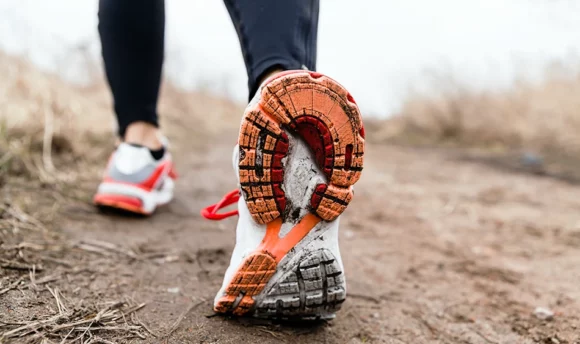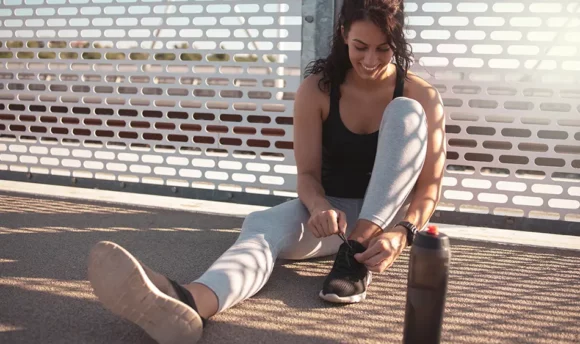How to Start Running at 50? Tips You Should Know About Running in Your 50s
It’s never too late to get your body moving. These tips will help you ease back into regular exercise.

Are you in your 50s and considering taking up running again? Although it might seem like a crazy idea, it’s totally doable – as long as you prepare yourself properly beforehand.
Even if you haven’t been active since college, that doesn’t mean that it’s too late for you to start making healthier choices. As long as you ease yourself back into the sport, there’s no reason you can’t be an avid runner once again.
In this article, we will cover some of the best ways for you to prepare yourself to run, as well as provide some helpful tips to help you create a running plan that fits your age and activity level.
Is It Too Late to Start Running in Your 50s?
It’s never too late to create healthier habits for yourself. Although there are certain precautions you will have to take in order to lower your risk for injury or complications, it’s more than okay to start running in your 50s.
5 Steps That Will Help You Start Running in Your 50s
By following these 5 steps, you will be able to get back into running risk-free. Proper preparation beforehand will help you avoid injuries and set yourself up for success in the long run.
#1 Consult with a family doctor
Before you begin running, make sure you talk to your doctor. Consulting with your family doctor before you begin running is a good idea for everyone, but especially if you are middle-aged.
It is possible that you have undiagnosed medical issues that can be triggered by exercise, especially if you have been living a sedentary life. During this exam, your doctor may perform an ECG to monitor your cardiovascular health and take your vitals to monitor your blood pressure.
Both of these tests can help you make sure you are ready for physical activity and won’t have any adverse reactions when you begin exercising.
If you experience any of the following symptoms while exercising, make sure to stop and talk to your doctor before starting again:
- Pain or discomfort in your chest, neck, or jaw
- Dizziness or lightheadedness
- Shortness of breath
- Swelling in the lower body
#2 Start with brisk walking
When you think of getting back into shape, walking probably isn’t the first thing that comes to mind. It’s so simple that it might not seem like it could have any sort of effect on your physical health. But brisk walking boasts a number of benefits and is a great way to get your body prepared for more intense physical activity.
Prepare yourself for your walks by getting a heart rate monitor. Monitoring your heart rate can allow you to exercise within a healthy range and not put unnecessary strain on your heart.
You will start by figuring out what your maximum heart rate is. You can find this number by subtracting your age from the number 220. If you are 50, then your maximum heart rate will be around 170.
Although this won’t give you a completely accurate number, it will give you an approximate you can use to base your workouts off of.
Ideally, when you walk, you will be between 50–60% of your maximum heart rate. This is your low-intensity zone. This is a zone that is safe for your heart, and you can expect that 85% of the calories you burn will be fat.
As your heart rate increases, you will burn more calories. Less of them will be stored fat, and instead, you will be burning energy that comes from carbohydrates. As your intensity increases, so will the load on your heart, so be mindful of your cardiovascular health as you increase your pace.
Monitor your heart rate and decrease your speed as needed. This will help you stay in a range that is healthy for you and your heart.
#3 Light jogging
If your body isn’t ready for running, you could try starting with light jogging instead. Both running and jogging are aerobic exercises that improve your cardiovascular health.
The main difference between the two is the level of intensity and the amount of impact on your bones and joints.
Running is considered a high-impact activity, meaning that it can put a lot of strain on your bones and joints. This is fine for people who have been working out regularly and preparing their bodies for more strenuous activity.
If you are getting back into running after years of inactivity, it’s important to take it slow and gradually build your body back into shape for high-intensity activity.
If you’re not sure what the difference between jogging and running is and what the health benefits you can get from both are, be sure to check out this article.
#4 Running at a slower pace
When you’re getting back into running, it’s a good idea to focus on your base runs. Base runs are when you run at your natural pace for as long as possible. While they’re not meant to be exceptionally challenging, they are meant to be done consistently.
Focus on finding a pace that you can maintain for 20–40 without having to take walking breaks. This will help you build your endurance, setting yourself up for longer distances in the future.
If you aren’t sure how to create a training plan for yourself, you could also try downloading an app to help you do so. Apps like Joggo create personalized training programs for all of their clients that take into account their age and current fitness level.

- Personalized running plans created by professional coaches
- Meal plans perfectly tailored to your current diet, allergies, and health needs
- Treadmill mode for people preferring indoor running
- Educational articles on easier running, injury prevention, nutrition, and more
- Behavior science-based reward system for lasting motivation
#5 Include cross-training
Strictly running will get you into better shape to run, but adding in cross-training, like strength training or cycling, can also be helpful.
Not only can it help regular runners overcome the boredom of always doing the same workout, but it can also give their bodies a break if they are suffering from running-related injuries. Lifting weights also strengthens the bones and muscles of the legs to help prevent injuries in the future.
Cycling
Cycling is a great exercise for you to use to cross-train for a few reasons.
Running is considered a high-impact sport, meaning that it can put a lot of stress on your muscles and joints. Cycling, on the other hand, is very low-impact, so it can give your body a much-needed break in between running days.
Not only that, but it is an exercise that targets mostly the lower legs. This means that it will build muscle mass in the same muscles you will be using when you run.
It is also a great cardiovascular exercise. Improving your cardiovascular health, therefore improving your running economy, will help you run longer distances.
Strength training
As mentioned before, running is a high-impact sport. Because of this, it’s important to be mindful of your bones and joints and do everything you can to make them as strong as possible.
Strength training helps strengthen the muscles around your joints, creating more joint stability as you run. Not only that, it helps ensure you don’t have any muscle imbalances in your body.
When one muscle is stronger than the opposing muscle – for example, quadriceps and hamstrings – it creates an imbalance, which can change the path of joint movement for your knee.
By doing strength training exercises, you can balance out the growth of the muscles in your lower body, improve your running form, and prevent future injury.
4 Extra Tips to Help You Get Back on Track at 50
Younger runners have less to worry about than older adults who are getting back into the sport. If you are over 50 and want to get back in better shape, these 4 running tips can help set you up for success.
#1 A balanced diet comes first
Eating a proper diet sets your body up for success before your workout even begins and can also aid in the body’s recovery process.
Carbohydrates are what give your muscles the energy they need to make it through an intense workout. Make sure you are eating enough healthy carbohydrates, like whole-grain pasta or brown rice, to give your body energy while you exercise.
Make sure you are also getting enough protein after your workout. Protein is what your muscles use to repair small tears that you make in them while exercising, causing your muscles to gain mass.
#2 Always stay hydrated
Proper hydration is important for optimal muscle function. Not drinking enough water before and after you run can cause your muscles to lose electrolytes and important minerals like magnesium.
Being well hydrated also helps cool your body down while you run. This is especially important if you are running in hot climates. Drinking the right amount of water for your body can help prevent things like heat stroke and cramping.
#3 Don’t forget to stretch before and after a training
If stretching before and after your runs isn’t already a part of your training routine, it should be.
Stretching before your run helps you mobilize your muscles and joints, allowing you to run properly with correct form, decreasing your chances of injury.
Fitting in a post-run stretch keeps your muscle fibers loose and long and can aid in the removal of lactic acid build-up, improving your recovery time. Meaning less muscle soreness the next day and being ready for another run faster.
#4 Increase gradually
You don’t need to start running 10 miles a day tomorrow to see results. In fact, going from not exercising at all to trying to bang out a 10-mile run would probably leave you injured and unable to run at all.
Start small, and then begin increasing your pace and mileage bit by bit as your muscles get stronger and your cardiovascular health improves.
It’s a good idea to use the 10% rule when you are exercising. If you start running 1 mile a day, then it’s a good idea to not make the leap to 2 miles a day immediately. Instead, next time you run, aim for 1.1 miles. Slowly but surely, build up your distance over time in a way that is healthy for your body.
Also, make sure you are still penciling in rest days, so your body has a chance to recover.
Choose the right gear
Choosing the right running gear for your workouts might not seem overly important, but comfortable clothing and the right shoes can actually make a sizable difference in your workouts.
Running shoes
The shoes you wear can have an effect on feelings of heaviness in your legs, as well as your running form. You want to make sure you choose shoes that are lightweight enough to not make your feet feel weighed down while you run.
It’s also important not to sacrifice when it comes to support. Wearing supportive shoes with enough cushion can minimize the impact on your bones and joints as you run.
Running clothing
Choose clothing that feels comfortable for you to run in. It should not be so tight that you have red marks on your skin after you run. Clothing that is too tight can limit your circulation and just generally make your runs too uncomfortable.
If you are running while overweight, then it is also important that you choose clothing that will safeguard you from chafing as you exercise.
Head to your local running store to pick up proper workout gear. There, they can help you pick out the right running shoe and point you in the direction of clothing that works for your body. This is a simple way for you to prepare yourself for success as you run.
A Word From Our Coach
What they say about choosing the right amount of days for your running program is true.
Take things slow, especially in the beginning. Start slow, and focus on creating consistent exercise habits that fit your lifestyle and current level of fitness.
Waking up at 5 AM for a run every day is a great goal, but starting with 3 early morning runs a week is a great place to start. Setting realistic goals sets you up for a major lifestyle change instead of another failed running routine.
Although it might be your goal to run a half-marathon or 10K a day, pushing your body too hard in the beginning could lead to injury. Either that or a sense of failure when you’re not able to maintain your new habits.
As always, the goal of any new training program should be for you to feel better! Focus on exercising to feel good and eating to fuel your body, and you will do more than just lose weight.
Bottom Line
In this article, we have outlined several tips and techniques for anyone wanting to know how to start running at 50. Things to keep in mind are:
- Checking with your doctor before starting any new exercise plan
- Starting with light jogging or brisk walking instead of running
- Cross-training to strengthen your body and avoid injuries
- Eating a balanced diet, including lots of water
- Stretching to reduce soreness and improve recovery time
It’s never a bad time for you to start a new running routine. Even if you are in your 50s or older, beginning to exercise again is always available to you. Using some of the tips in this article will help you do so safely.

















































 Select your language:
Select your language: 








